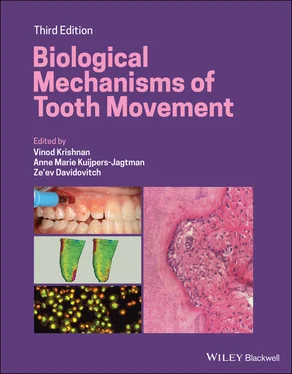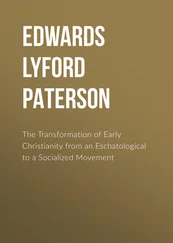
Figure 2.24 The number of alveolar bone osteoblasts bordering the PDL (±SEM) near cat maxillary canines, intensely stained for cAMP or cGMP following an electric stimulation. Cells were counted along a 0.1 mm surface opposite each electrode. Open circles, Control sites. Solid circles, Electrically treated sites. (a) Osteoblasts near cathode stained for cAMP. (b) Osteoblasts near anode, stained for cAMP. (c) Osteoblasts near cathode, stained for cGMP. (d) Osteoblasts near anode, stained for cGMP. Time periods when differences in number of cells intensely stained for cAMP and cGMP between electrically treated and control sites were not significant: cAMP near the cathode at day 3; cGMP at days 3 and 7 near the cathode. At the other time periods near the cathode and at all time periods near the anode, the differences between the treated and control sites were statistically significant ( P < 0.01). It should be noted that all the bone surface cells are labeled as “osteoblasts,” although it is quite possible that some cells near the anode are stimulated by the electric currents to resorb bone rather than to participate in the synthesis and mineralization of new bone matrix. However, the authors did not detect typical osteoclastic lacunae at the alveolar socket wall near the anode and thus defined all bone surface cells as osteoblasts.
(Source: Davidovitch, 1980a. Reproduced with permission of Elsevier.)
The major criticism faced by both the piezoelectric as well as the streaming potentials theories was due to the highly conductive nature of the vascular system, periosteum, and tissue fluids. They often tend to drain away the change in potential difference. Researchers failed to establish whether the generated strain‐induced potentials were actual players in cellular remodelling or irrelevant by‐products of bone deformation. McDonald (1993) argued against the role of electrical signals in bone remodeling by stating that “surface potential differences are very small compared to the potential differences generated with muscle activity.” He concluded that the knowledge of action of electrical signaling inside the cells is inadequate and warrants further research into cellular behavior in response to applied mechanical forces.
It is evident from the ongoing discussion that neither of these hypotheses could provide conclusive evidence on the detailed nature of the biological mechanism of OTM. Histological, histochemical, and immunohistochemical studies performed in the twentieth century, as well as early in the twenty‐first century, have demonstrated that multiple phenomena, both physical and chemical, are involved in the process of tooth movement. When mechanical forces are applied, cells, as well as the ECM of the PDL and alveolar bone, respond concomitantly, resulting in tissue remodeling activities. During early phases of tooth movement, PDL fluids are shifted, producing cell and matrix distortions as well as interactions between these tissue elements. In response to these physicochemical events and interactions, cytokines, growth factors, colony stimulating factors, and vasoactive neurotransmitters are released, initiating and sustaining the remodeling activity, which facilitates the movement of teeth. A detailed discussion on these molecules along with the mechanisms of their operation is provided in Chapter 3.
Our ancestors noticed, two or three millennia ago, that malposed teeth can be straightened by the application of mechanical force to the crowns of those teeth. With the passage of time, a large variety of devices had been designed in order to correct malocclusions, and were usually claimed to be superior to other appliances aiming at the same targets. The inability to determine which of those gadgets would be best for clinical use was limited by the paucity of biological information that could support most of the claims made by their inventors. However, there was a breakthrough with the introduction of histology into orthodontics at the start of the twentieth century. The visualization of the response of tissues and cells to mechanical forces opened the gate to thoughtful proposals of hypotheses, to explain the reason for tooth movement. The two prevailing dogmas during the following decades were the “pressure–tension” and the “bone‐bending” hypotheses. Other hypotheses stemming from these two focused on the roles of the dynamics of tissue fluids and evoked electric potentials in the strained tissues in OTM. Altogether, each of these hypotheses improves our understanding of the fundamental principles of OTM. Additional building blocks to assist in crafting a unified theory based on biological evidence have been derived from research at the cellular and molecular levels, which is reviewed in the next chapter.
1 Anderson, J. C. and Eriksson, C. (1968) Electrical properties of wet collagen. Nature 218, 166–168.
2 Anderson, J. C. and Eriksson, C. (1970) Piezoelectric properties of dry and wet bone. Nature 227, 491–492.
3 Angle, E. H. (1907) Treatment of Malocclusion of the Teeth: Angle’s System, 7th edn, White Dental Manufacturing Co., Philadelphia.
4 Basset, C. A. L. (1968) Biologic significance of piezoelectricity. Calcified Tissue Research 1, 252–272.
5 Basset, C. A. L. and Becker, R. O. (1962) Generation of electric potentials by bone in response to mechanical stress. Science 137, 1063–1065.
6 Baumrind, S. (1969) A reconsideration of the property of the pressure tension hypothesis. American Journal of Orthodontics 55, 12–22.
7 Bien, S. M. (1966) Hydrodynamic damping of tooth movement. Journal of Dental Research 44(3), 907–914.
8 Borgens, R. B. (1984) Endogenous ionic currents traverse intact and damaged bone. Science 225, 478–482.
9 Cochran, G. V. B., Pawluk, R. J. and Bassett, C. A. L. (1968) Electromechanical characteristics of bone under physiologic moisture conditions. Clinical Orthopedics 58, 249–270.
10 Davidovitch, Z. (1991) Tooth movement. Critical Reviews in Oral Biology and Medicine, 2, 411–450.
11 Davidovitch, Z., Finkelson, M.D., Steigman, S. et al. (1980a) Electric currents, bone remodeling and orthodontic tooth movement. I—The effect of electric currents on periodontal nucleotides. American Journal of Orthodontics 77, 14–32.
12 Davidovitch, Z., Finkelson, M. D., Steigman, S. Et al. (1980b) Electric currents, bone remodeling and orthodontic tooth movement. II—Increase in rate of tooth movement and periodontal cyclic nucleotide levels by combined force and electric current. American Journal of Orthodontics 77, 33–47.
13 Epker, B. N. and Frost, H. M. (1965) Correlation of bone resorption and formation with the physical behavior of loaded bone. Journal of Dental Research 44, 33–41.
14 Farrar, J. N. (1888) Irregularities of the Teeth and Their Correction, DeVinne Press, New York, Vol. 1, Chapter 62, p. 658.
15 Frost, H. M. (1983) The regional acceleratory phenomenon: a review. Henry Ford Hospital Medical Journal 31, 3–9.
16 Fukada, E. and Hara, A. (1969) Piezoelectric effects in blood vessel walls. Journal of Physics Society of Japan 26, 777–780.
17 Fukada, E. and Yasuda, I. (1957) On the piezoelectric effect on bone. Journal of Physics Society of Japan 12, 1158–1162.
18 Gross, D. and Williams, W. S. (1982) Streaming potential and the electromechanical response of physiologically‐moist bone. Journal of Biomechanics 15(4), 277–295.
19 Hays, D. F. (1961) Squeeze films, a finite bearing with a fluctuating load. Transactions of the American Society of Mechanical Engineering Series D 83, 579–588.
Читать дальше













